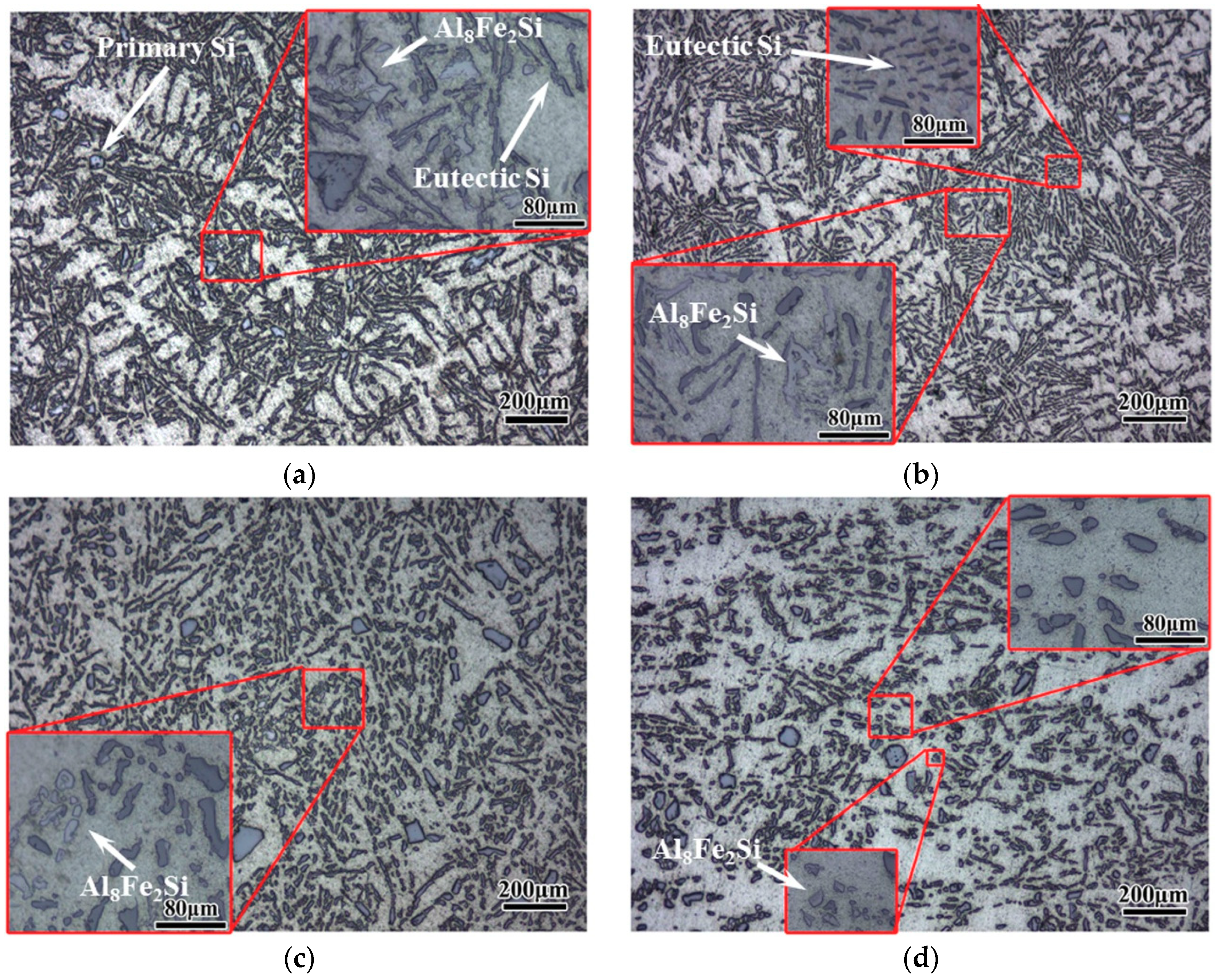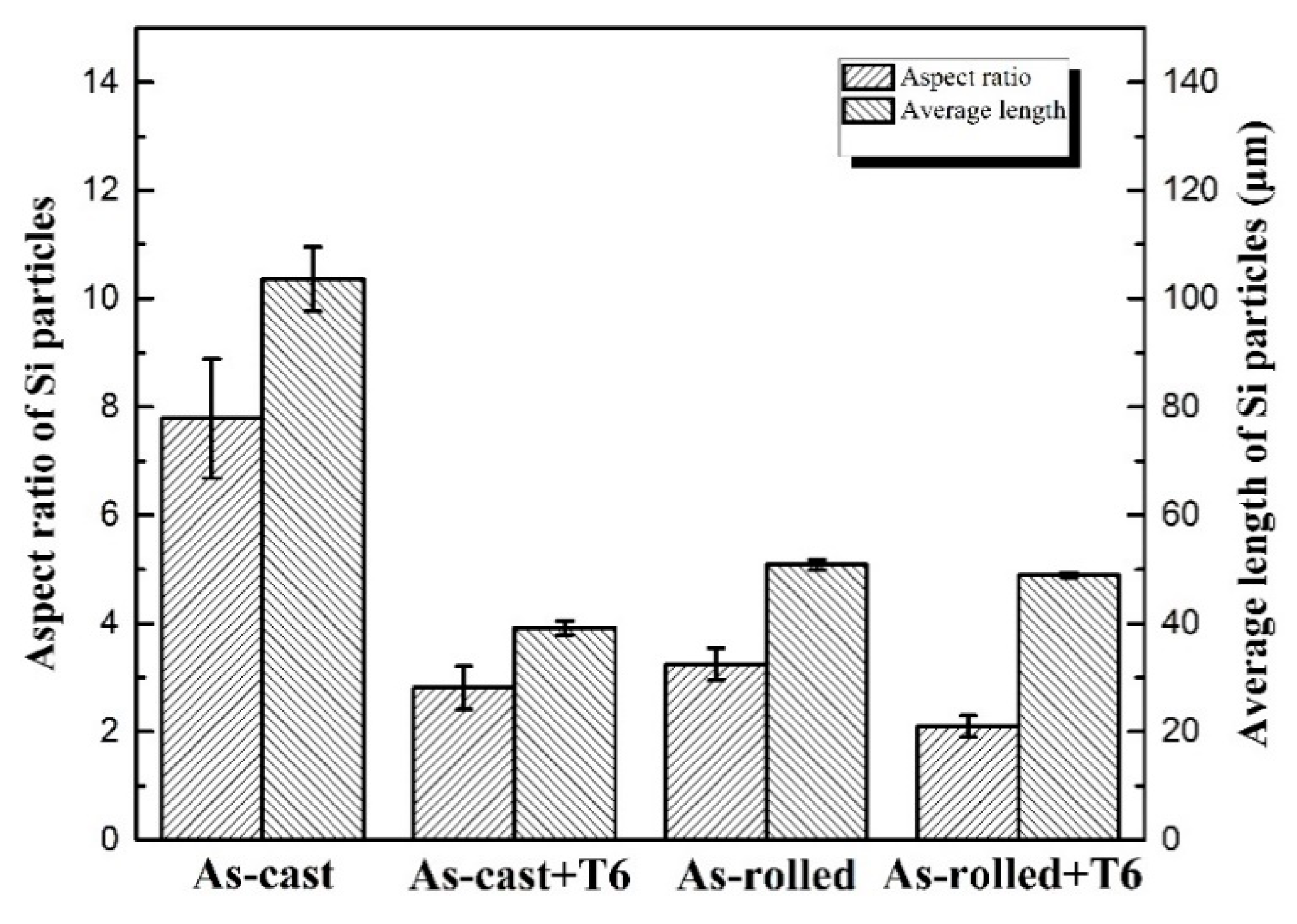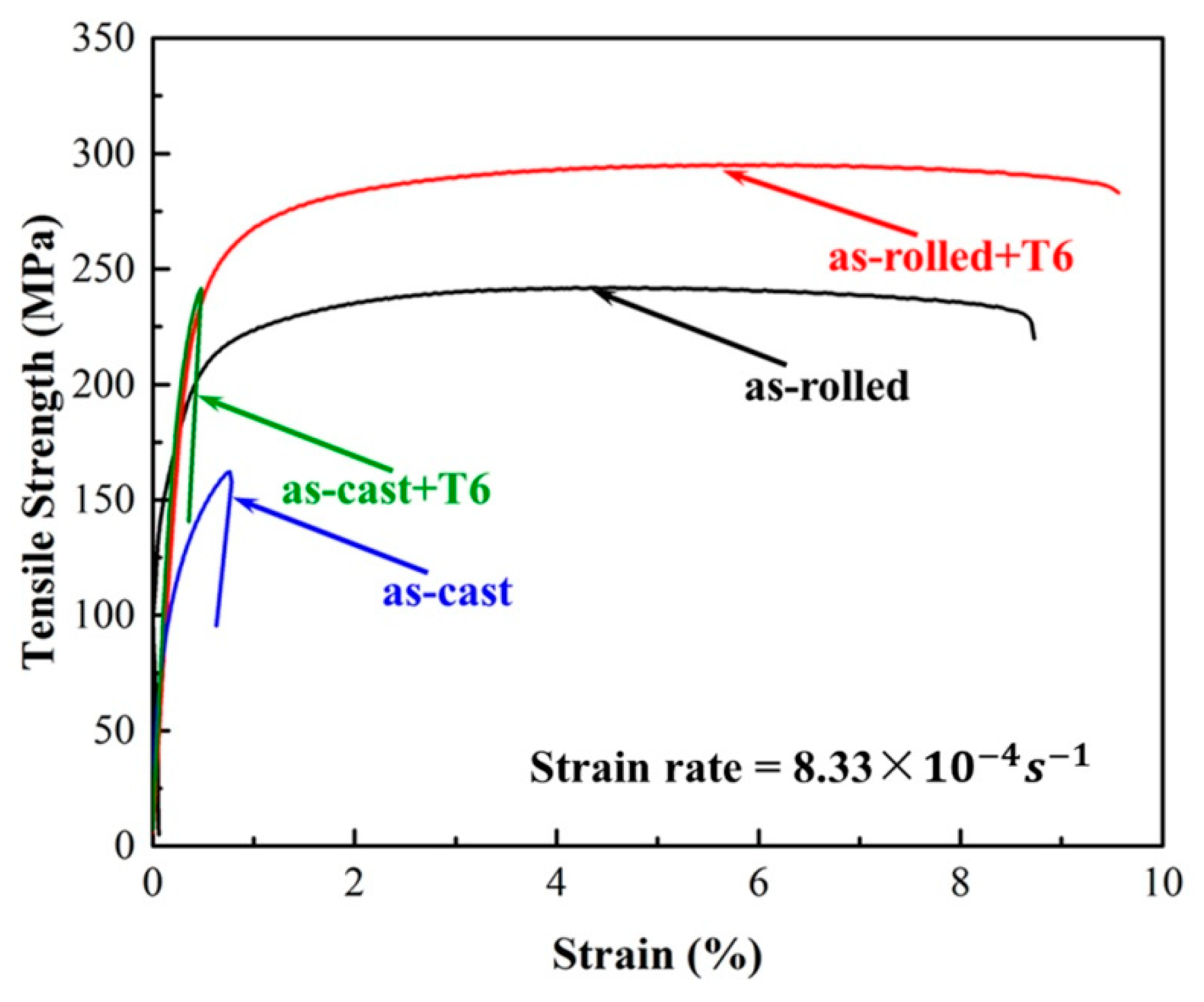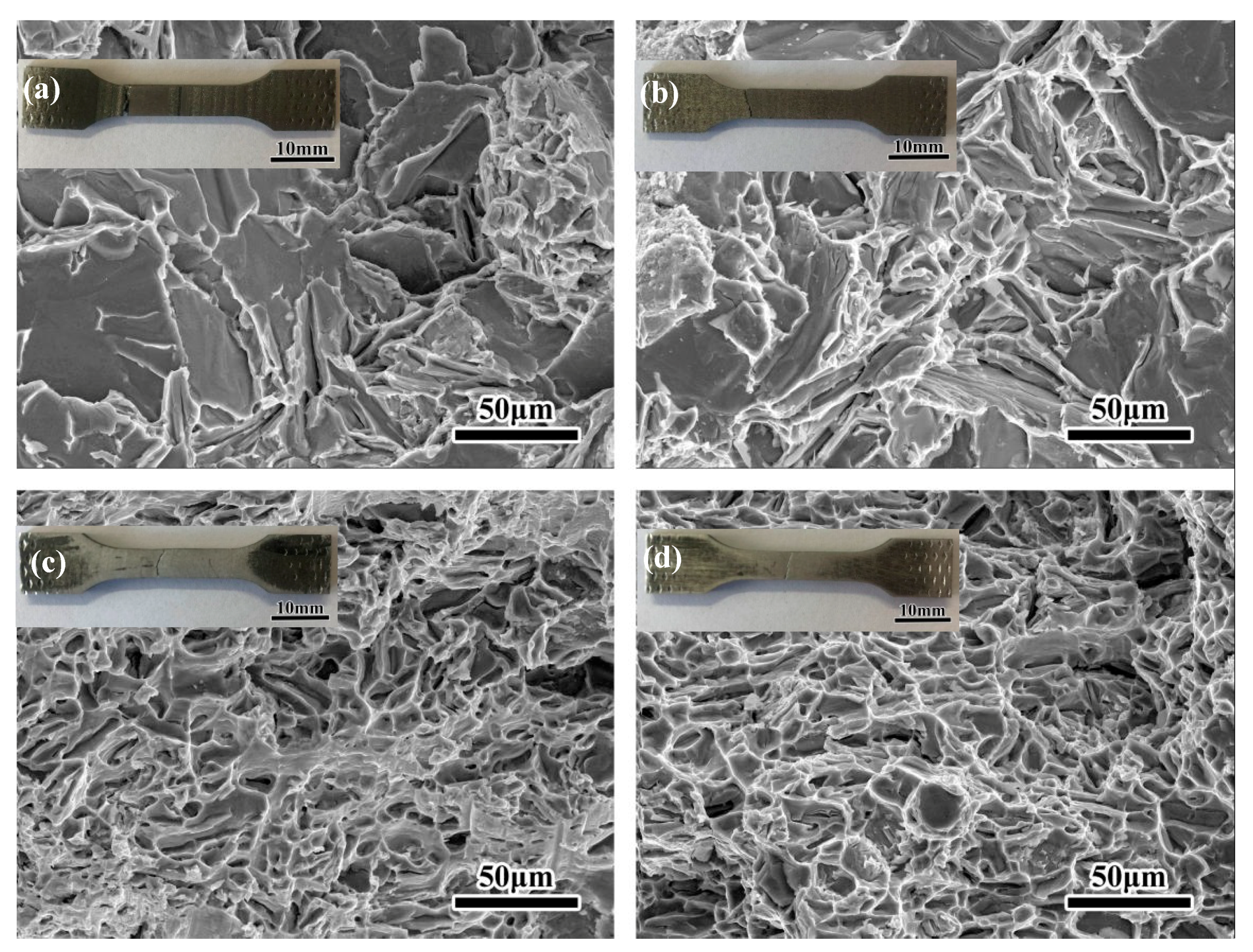A Study of the Mechanical and Thermal Characteristics of an Al-Si-Fe Alloy Fabricated by Rolling and Heat Treatment
Abstract
:1. Introduction
2. Materials and Methods
3. Results
3.1. Microstructures
3.2. Thermal Properties
3.3. Mechanical Properties
4. Discussion
5. Conclusions
- The thermal properties, including the thermal conductivity and thermal diffusivity of the Al-Si-Fe alloy, were mainly affected by the morphology of the silicon phase. A smaller average length and aspect ratio for the silicon phase could improve the thermal properties of the alloy. However, the morphology of the precipitated Al8Fe2Si phase had no evident effect on the thermal properties.
- The average length and aspect ratio of the silicon particles could influence the ultimate tensile strength of Al-Si-Fe alloys. The improvement of the elongation of the alloy was mainly caused by matrix grain refinement and spheroidization of the silicon particles, but the average length of silicon particles had no effect on elongation.
- The thermal conductivity of the Al-Si-Fe alloy fabricated by rolling with a T6 treatment was 188.22 W/(m·K), which exceeded by 1.2 times that of the as-cast Al-Si-Fe alloy. The final tensile strength, yield strength, and elongation were 244.28 MPa, 295.21 MPa, and 9.56%, respectively.
Author Contributions
Funding
Conflicts of Interest
References
- Li, Z.; Samuel, A.M.; Samuel, F.H.; Ravindran, C.; Valtierra, S.; Doty, H.W. Parameters Controlling the performance of AA319-type alloys: Part I. tensile properties. Mater. Sci. Eng. A 2004, 367, 96–110. [Google Scholar] [CrossRef]
- Jamaati, R.; Amirkhanlou, S.; Toroghinejad, M.R.; Niroumand, B. Significant improvement of semi-solid microstructure and mechanical properties of A356 alloy by ARB process. Mater. Sci. Eng. A 2011, 528, 2495–2501. [Google Scholar] [CrossRef]
- Jeong, C.Y. High temperature mechanical properties of Al–Si–Mg–(Cu) alloys for automotive cylinder heads. Mater. Trans. 2013, 54, 588–594. [Google Scholar] [CrossRef]
- Yao, J.Y.; Taylor, J.A. Characterisation of intermetallic particles formed during solution treatment of an Al-7Si-0.4Mg-0.12Fe alloy. J. Alloys Compd. 2012, 519, 60–65. [Google Scholar] [CrossRef]
- Ammar, H.; Samuel, A.; Samuel, F.; Simielli, E.; Sigworth, G.; Lin, J. Influence of aging parameters on the tensile properties and quality index of Al-9 Pct Si-1.8 Pct Cu-0.5 Pct Mg 354-Type casting alloys. Metall. Mater. Trans. A 2012, 43, 61–73. [Google Scholar] [CrossRef]
- Zhao, Q.R.; Cui, X.L.; Qian, Z.; Liu, X.F. The synergistic effect of Al-B-C master alloy to improve conductivity and strength of 1070 alloy. J. Alloys Compd. 2015, 639, 478–482. [Google Scholar] [CrossRef]
- Lumley, R.N.; Deeva, N.; Larsen, R.; Gembarovic, J.; Freeman, J. The role of alloy composition and T7 heat treatment in enhancing thermal conductivity of aluminum high pressure diecastings. Metall. Mater. Trans. A 2012, 44, 1074–1086. [Google Scholar] [CrossRef]
- Chen, J.K.; Hung, H.Y.; Wang, C.F.; Tang, N.K. Thermal and electrical conductivity in Al-Si/Cu/Fe/Mg binary and ternary Al alloys. J. Mater. Sci. 2015, 50, 5630–5639. [Google Scholar] [CrossRef]
- Choi, S.W.; Kim, Y.M.; Lee, K.M.; Cho, H.S.; Hong, S.K.; Kim, Y.C.; Kang, C.S.; Kumai, S. The effects of cooling rate and heat treatment on mechanical and thermal characteristics of Al-Si-Cu-Mg foundry alloys. J. Alloys Compd. 2014, 617, 654–659. [Google Scholar] [CrossRef]
- Choi, S.W.; Cho, H.S.; Kang, C.S.; Kumai, S. Precipitation dependence of thermal properties for Al-Si-Mg-Cu-(Ti) alloy with various heat treatment. J. Alloys Compd. 2015, 647, 1091–1097. [Google Scholar] [CrossRef]
- Kim, Y.M.; Choi, S.W.; Hong, S.K. The behavior of thermal diffusivity change according to the heat treatment in Al-Si binary system. J. Alloys Compd. 2016, 687, 54–58. [Google Scholar] [CrossRef]
- Choi, S.W.; Cho, H.S.; Kumai, S. Effect of the precipitation of secondary phases on the thermal diffusivity and thermal conductivity of Al-4.5Cu alloy. J. Alloys Compd. 2016, 688, 897–902. [Google Scholar] [CrossRef]
- Stadler, F.; Antrekowitsch, H.; Fragner, W.; Kaufmann, H.; Pinatel, E.R.; Uggowitzer, P.J. The effect of main alloying elements on the physical properties of Al–Si foundry alloys. Mater. Sci. Eng. A 2013, 560, 481–491. [Google Scholar] [CrossRef]
- Wu, Y.N.; Zhang, J.F.; Liao, H.C.; Wang, Y.J.; Wu, Y.P. Effect of homogenization temperature on microstructure and conductivity of Al-Mg-Si-Ce alloy. J. Mater. Eng. Perform. 2016, 25, 2720–2726. [Google Scholar] [CrossRef]
- Zhang, C.; Du, Y.; Liu, S.H.; Liu, S.J.; Jie, W.Q.; Sundman, B. Microstructure and thermal conductivity of the as-cast and annealed Al–Cu–Mg–Si alloys in the temperature range from 25 °C to 400 °C. Int. J. Thermophys. 2015, 36, 2869–2880. [Google Scholar] [CrossRef]
- Lumley, R.N.; Polmear, I.J.; Groot, H.; Ferrier, J. Thermal characteristics of heat-treated aluminum high-pressure die-castings. Scr. Mater. 2008, 58, 1006–1009. [Google Scholar] [CrossRef]
- Chen, J.K.; Hung, H.Y.; Wang, C.F.; Tang, N.K. Effects of casting and heat treatment processes on the thermal conductivity of an Al-Si-Cu-Fe-Zn alloy. Int. J. Heat Mass Transf. 2017, 105, 189–195. [Google Scholar] [CrossRef]
- Wang, Y.; Liao, H.; Wu, Y.; Yang, J. Effect of Si content on microstructure and mechanical properties of Al-Si-Mg alloys. Mater. Des. 2014, 53, 634–638. [Google Scholar] [CrossRef]
- Adamczyk-Cieślak, B.; Mizera, J.; Kurzydłowski, K.J. Microstructures in the 6060 aluminium alloy after various severe plastic deformation treatments. Mater. Charact. 2011, 62, 327–332. [Google Scholar] [CrossRef]
- Liao, H.C.; Wu, Y.N.; Wang, Y.J. Microstructure evolution of Al-0.35%Si-0.2%Mg-0.3%Ce alloy during hot extrusion and its contributions to performances. J. Mater. Eng. Perform. 2015, 24, 2503–2510. [Google Scholar] [CrossRef]
- Morozova, A.; Mogucheva, A.; Bukin, D.; Lukianova, O.; Korotkova, N.; Belov, N.; Kaibyshev, R. Effect of Si and Zr on the microstructure and properties of Al-Fe-Si-Zr alloys. Metals 2017, 7, 495. [Google Scholar] [CrossRef]
- Zhao, Q.R.; Qian, Z.; Cui, X.L.; Wu, Y.Y.; Liu, X.F. Influences of Fe, Si and homogenization on electrical conductivity and mechanical properties of dilute Al-Mg-Si alloy. J. Alloys Compd. 2016, 666, 50–57. [Google Scholar] [CrossRef]
- Sadeghi, I.; Wells, M.A.; Esmaeili, S. Modeling homogenization behavior of Al-Si-Cu-Mg aluminum alloy. Mater. Des. 2017, 128, 241–249. [Google Scholar] [CrossRef]
- Lados, D.A.; Apelian, D.; Wang, L.B. Solution treatment effects on microstructure and mechanical properties of Al-(1 to 13 pct)Si-Mg cast alloys. Metall. Mater. Trans. B 2011, 42B, 171–180. [Google Scholar] [CrossRef]
- Sharma, R.; Anesh; Dwivedi, D.K. Influence of silicon (wt.%) and heat treatment on abrasive wear behaviour of cast Al-Si-Mg alloys. Mater. Sci. Eng. A 2005, 408, 274–280. [Google Scholar] [CrossRef]
- Li, B.C.; Hou, L.; Wu, R.Z.; Zhang, J.H.; Li, X.L.; Zhang, M.L. Microstructure and thermal conductivity of Mg-2Zn-Zr alloy. J. Alloys Compd. 2017, 722, 772–777. [Google Scholar] [CrossRef]
- Ying, T.; Zheng, M.Y.; Li, Z.T.; Qiao, X.G. Thermal conductivity of as-cast and as-extruded binary Mg–Al alloys. J. Alloys Compd. 2014, 608, 19–24. [Google Scholar] [CrossRef]
- Panigrahi, S.K.; Jayaganthan, R.J. Development of ultrafine grained high strengthage hardenable Al 7075 alloy by cryorolling. Mater. Des. 2011, 32, 3150–3160. [Google Scholar] [CrossRef]
- Gurua, P.R.; Khan MD, F.; Panigrahia, S.K.; Janaki Ramb, G.D. Enhancing strength, ductility and machinability of a Al–Si cast alloy by friction stir processing. J. Manuf. Process. 2015, 18, 67–74. [Google Scholar] [CrossRef]
- Immanuel, R.J.; Panigrahi, S.K. Influence of cryorolling on microstructure and mechanical properties of a cast hypoeutectic Al–Si alloy. Mater. Sci. Eng. A 2015, 640, 424–435. [Google Scholar] [CrossRef]





| Si | Fe | Mg | Ni | Mn | Zn | Others | Al |
|---|---|---|---|---|---|---|---|
| 11.38 | 0.403 | 0.2352 | 0.0507 | 0.0156 | 0.0138 | 0.007 | Bal. |
| Treatment | Microstructure | Thermal Properties | |||
|---|---|---|---|---|---|
| Morphology (Eutectic Si) | Average Length (Si) (μm) | Specific Heat Capacity (J/kg/K) | Thermal Conductivity (W/(m·K)) | Thermal Diffusivity (m2/s) | |
| As-cast | Needle-like | 103.62 ± 5.9 | 0.963 ± 0.027 | 155.99 ± 0.18 | 61.944 ± 0.028 |
| As-cast + T6 | Broken-needle | 39.19 ± 1.3 | 1.009 ± 0.013 | 188.82 ± 0.39 | 71.563 ± 0.029 |
| As-rolled | Block-shape | 50.85 ± 0.9 | 1.004 ± 0.009 | 170.24 ± 0.22 | 64.769 ± 0.047 |
| As-rolled + T6 | Near-spheroidal | 48.96 ± 0.43 | 1.012 ± 0.019 | 188.22 ± 0.16 | 71.043 ± 0.058 |
| Treatment | Microstructure | Mechanical Properties | |||
|---|---|---|---|---|---|
| Morphology (Eutectic Si) | Average Length (Si) (μm) | Tensile Test Ultimate Tensile Strength (MPa) | Yield Strength (MPa) | Elongation (%) | |
| As-cast | Needle-like | 103.62 ± 5.9 | 162.05 ± 4.94 | 122.56 ± 6.45 | 0.78 ± 0.14 |
| As-cast + T6 | Broken-needle | 39.19 ± 1.3 | 241.50 ± 6.21 | 239.37 ± 5.57 | 0.48 ± 0.11 |
| As-rolled | Block-shape | 50.85 ± 0.9 | 241.98 ± 1.52 | 203.27 ± 3.29 | 8.73 ± 0.18 |
| As-rolled + T6 | Near-spheroidal | 48.96 ± 0.43 | 295.21 ± 2.38 | 244.28 ± 8.18 | 9.56 ± 0.23 |
© 2018 by the authors. Licensee MDPI, Basel, Switzerland. This article is an open access article distributed under the terms and conditions of the Creative Commons Attribution (CC BY) license (http://creativecommons.org/licenses/by/4.0/).
Share and Cite
Guo, Y.; Wang, Y.; Yang, J.; Xu, H.; Hu, M.; Ji, Z. A Study of the Mechanical and Thermal Characteristics of an Al-Si-Fe Alloy Fabricated by Rolling and Heat Treatment. Metals 2019, 9, 9. https://doi.org/10.3390/met9010009
Guo Y, Wang Y, Yang J, Xu H, Hu M, Ji Z. A Study of the Mechanical and Thermal Characteristics of an Al-Si-Fe Alloy Fabricated by Rolling and Heat Treatment. Metals. 2019; 9(1):9. https://doi.org/10.3390/met9010009
Chicago/Turabian StyleGuo, Yu, Ye Wang, Jieren Yang, Hongyu Xu, Maoliang Hu, and Zesheng Ji. 2019. "A Study of the Mechanical and Thermal Characteristics of an Al-Si-Fe Alloy Fabricated by Rolling and Heat Treatment" Metals 9, no. 1: 9. https://doi.org/10.3390/met9010009





